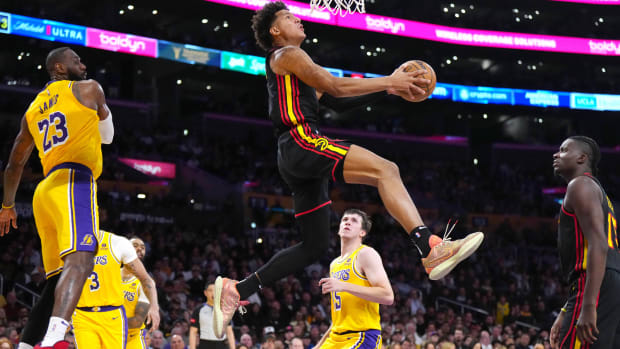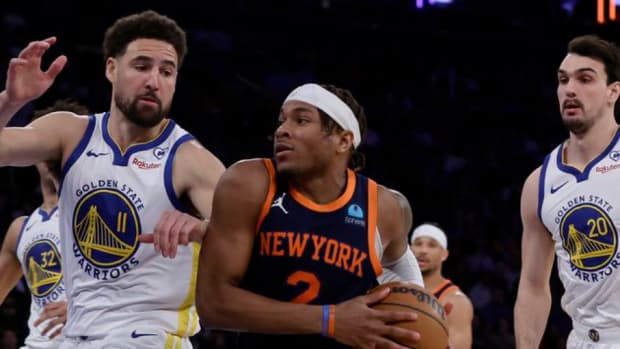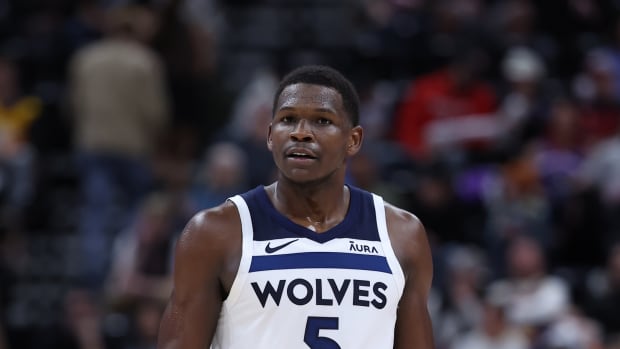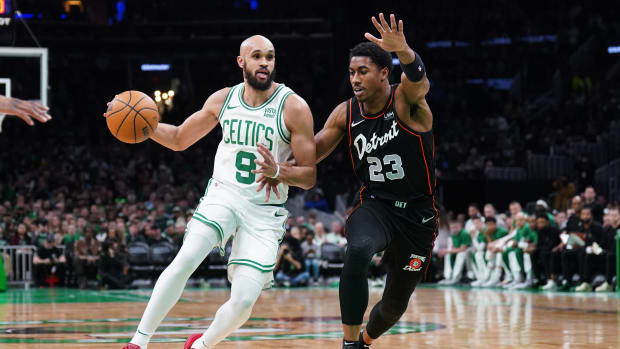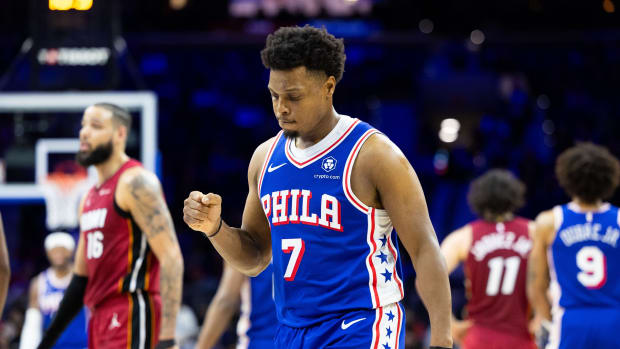Last Night on 'The Last Dance': Episodes 5 & 6
The tears come early. Twenty-eight seconds into Sunday night’s Episode 5 of The Last Dance we hear the voice of ESPN’s Stuart Scott (1965–2015). And 24 seconds—yes, 24 seconds—after that we see 19-year-old Kobe Bean Bryant (1978–2020) pass by Michael Jordan in the Madison Square Garden hallway of his first NBA All-Star Game, back in 1998. A few minutes later we see NBA commissioner David Stern (1942–2020) announcing Jordan as that game’s MVP.
Sic transit gloria.
Yet another Latin saw—veni, vidi, vici—comes to mind as we watch Jordan lay waste to various foes, real and imagined, in the fifth and sixth hours of our national pandemic magnet. Is there any challenge this man ever ignored? Any slight he has ever brushed off his tailored suit without lingering on it? His eyes light on fire as he talks about vanquishing fellow Dream Teamer Clyde Drexler in the 1992 NBA Finals—but also the Suns’ Dan Majerle, in the ’93 Finals.
Dan Majerle is still on his mind? Oh, it turns out that Chicago general manager Jerry Krause complimented Majerle’s defense. Now we get it.
To read previous episode recaps, click here.
Sunday was also the night that director Jason Hehir applied a coating of clay to Jordan’s feet. The Last Dance weaves into its yo-yo-ing narrative the characters of James (Slim) Bouler and Richard Esquinas, those Elmore Leonardish–named rapscallions from Jordan’s gambling past. We get the nasty-tempered MJ from Sam Smith’s The Jordan Rules, who was cruel to his teammates, punched Will Perdue and held sway over practices like a schoolyard bully. There’s the politically oblivious Jordan, who ignores the entreaties of his mother, Deloris, to say something—anything—on behalf of Harvey Gantt, the black candidate who ran a Senate campaign against the execrable racist Jesse Helms, in 1990. Jordan tells us he just couldn’t get involved. . . . But, hey, he did send him a check. (Of all the things one could hold against Jordan, by the way, going against Mom is near the top of the list. After basking in Deloris’s soothing presence over six episodes, I would gladly tile her kitchen if she so requested, though I am a terrible tiler.)
Of course, by the time we get to the clay we have already been shown what is most manifestly on Michael’s feet, the birth of Nike’s Air Jordans having been spun out in Episode 5. The Jordan sneaker calculus would be mind-boggling even if we weren’t digesting it in the midst of our sinking-like-a-stone economy. We’ll let Jordan’s then agent tell the tale, for it was David Falk who saw a dead-end deal with Converse (the hoops sneaker king in those days) and a nowhere path with Adidas (Jordan’s first favored shoe), and instead turned his sights toward a company whose obscure logo represented … half of a running track? What the hell is a Swoosh?
“At the end of Year 4, [Nike] hoped to sell $3 million worth of Air Jordans,” says Falk. “In Year 1 we sold $126 million.” Falk said this during a break in the filming, and it was so staggering that Hehir turned the camera on and asked him to repeat it.

Nike projected $3M in four years for MJ's kicks. They did $126 in one instead.
Kelly Kline/WireImage for Bragman Nyman Cafarelli/Getty Images
And, so, on Episodes 5 and 6, two irreconcilable forces do battle: Pedestal vs. Manufactured Image. Did we build Michael up only to knock him down? Or did he and the rest of Jordan Inc. work so hard to create an image—for his own commercial gain—that the foundation was built on sand, that it ultimately had to crumble from its own weight?
A little of both, says the writer, bailing out of the batter’s box. But I’ll also make this point. The one thing I’ve said about Jordan for a long time is: On the court, he was always better than his hype; he always exceeded our expectations of him as a player, a difficult thing to do when you had that much hype.
Predictably, Jordan, pertinacious even clad in a pair of Tennis, anyone? white shorts, takes on all questions in these two hours and swats them away with the same ferocity that he rejects a Patrick Ewing shot during the heated 1993 Eastern Conference Finals against the Knicks. And at the end of Episode 6 he stands as he did throughout the first four hours of the doc: a little bowed in the minds of some but certainly not bloodied. And his opponents? Bloodied. All of them.
***
There has been some muttering in the Twitterverse that The Last Dance skips around too freely in time, particularly for younger viewers who may not be so familiar with the particulars of Jordan’s story. “From the beginning, our big challenge was chronology,” acknowledges Hehir. “We have two simultaneous timelines: one from the 1997–98 season [when the NBA Entertainment film crew had almost unfettered access to Jordan and the Bulls], and then the through line of Michael’s whole career, from ’84 to ’98.” Sunday night’s episodes indeed covered a dizzying amount of ground, and sometimes we felt like passengers in Doc Brown’s DeLorean, pinballing from era to era like groggy time travelers.
Episode 5 alone covers that 1998 All-Star Game and a regular-season contest one month later at Madison Square Garden; it goes back to Nike’s sneaker seduction; it returns to the game at MSG; retreats to a point early in the ’91 season; continues on to the ’92 Finals and the Dream Team in Monte Carlo and Barcelona; makes a hard pivot to the issue of Jordan's staying silent on politics (hello again, President Obama; and welcome, Muhammad Ali); and finally plants us back at a late-season ’98 game in the Georgia Dome, where 62,000 fans, many whose interest in pro hoops ranked far below their interest in Georgia Tech’s spring game, turned out for what they figured was Jordan’s last appearance.
Episode 6 is somewhat less encumbered and includes much from that eventful 1993 Eastern Conference finals, when Knicks forward Charles Smith missed more shots during one six-second sequence of Game 5 than Jordan misses in 10 hours of documentary. If I’m not mistaken, Bulls broadcaster Johnny (Red) Kerr left his post and came down to swat away one of Smith’s four attempts. But the episode also attacks one of the documentary’s Big Issues. To wit: How hath the pressures of fame and fortune ravaged our hero? We embark on an Odysseus-like journey, only with fewer serpents and way more dunks and cigars. “Let them try to be Michael Jordan for a year,” MJ says as he reclines, exhausted, in an anonymous hotel room, the imprisoned-in-a-golden-cage implications obvious. “See if they like it.”
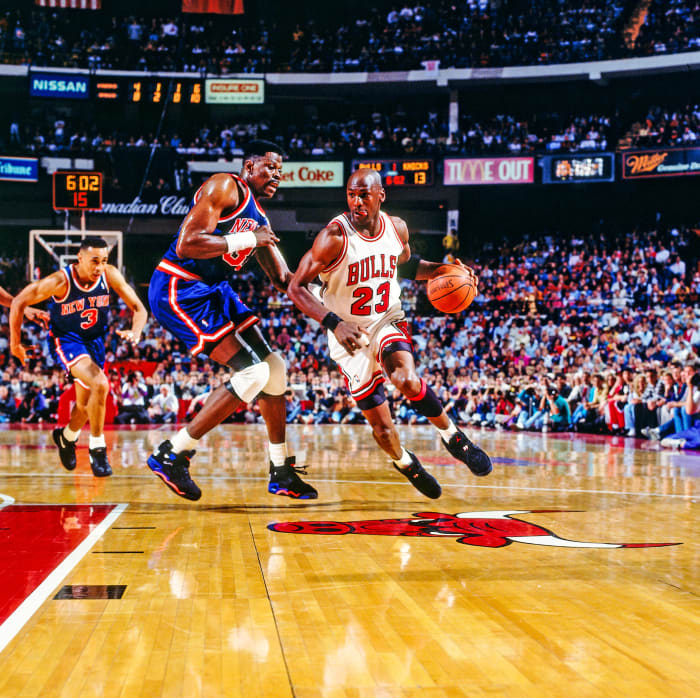
MJ and the Bulls, back in Chicago after digging a 2-0 New York hole in 1993.
Nathaniel S. Butler/NBAE/Getty Images
There is a lot of story here, and—acknowledging that linear narration might be, like foolish consistency, the hobgoblin of little minds (thank you R.W. Emerson)—some old-fashioned, straight-ahead chronology might be helpful. Jordan’s on-court and off-court life from 1991 to ’93 is packed solid with triumph, turmoil, tragedy and, eventually, transition—and he lived it in the most public fashion, huge ladlefuls of his private life dished out at precisely the same time that his professional excellence is nonpareil.
Jordan saw this coming even earlier than it might seem in The Last Dance. In November 1991 I interviewed him in conjunction with his being named Sports Illustrated’s Sportsman of the Year. Instead of the usual I’d like to thank my teammates stuff—Jordan wasn’t much for that anyway—he turned inward, saying:
Signs are starting to show that people are tired of hearing about Michael Jordan's positive image and Michael Jordan's positive influence. . . . I've always tried to project everything positive. People say you need role models in the world, and people were asking for them, and I never thought a role model should be negative. If you wanted negativity, then you wouldn't have asked for Michael Jordan. . . .
In retrospect, maybe I was wrong. Maybe I should've shown some negativity, so people had a sense of me as a human being. I could've been more honest, I guess, about some of the mistakes I made. . . . I did hit [teammate] Will Perdue in the face. That was a mistake, and I could've talked about it. I've made some bad endorsements, like Time Jordan [a watch deal Jordan signed with a Canadian company, Excelsior, that never got ticking]. But what do you know when you're 21 and 22 going through all this? You mature as you go through it all, but you're not mature when it starts.
What had happened by then to turn Jordan so introspective? Well, in October 1991 he skipped out on the Bulls’ championship visit to George H.W. Bush’s White House to play golf. That brought him a lot of grief, not just from Republicans. And what a fateful golf trip it was. That’s when Jordan headed to Hilton Head, S.C., and met up with the aforementioned Bouler. (Back to that later.) It didn’t help Jordan that everyone else on the Bulls attended, including the liberal Phil Jackson and the Muslim Craig Hodges, who wore a striking white dashiki. Now that was a political statement, considering that it came eight months after Bush’s Gulf War in Iraq and Kuwait.
The following month, Sam Smith’s The Jordan Rules hit bookstores and rocketed to the top of every list, even managing to move Magic Johnson, two weeks removed from his HIV announcement, off the front sports page. Discovering that Jordan could be a real a-hole to his teammates was not a revelation to those who understood his competitive fire. But the book, which remains a classic, had the power of strong narrative, the weight of detail.
So, in the minds of millions, did Jordan suddenly go from Disney hero to Marvel villain? What percentage of the collective public mind changed on the subject of Jordan’s too-good-to-be-true image? I honestly have no idea. But to those who form their opinions about athletes/celebrities/politicians based on commercial packaging, I say: That’s on you. Caveat emptor, baby. The same thing has happened dozens of times to sports celebrities. Huh? Tiger Woods isn’t a smiling innocent who lives only to tee it up? It’s just that the Jordan Fishbowl was first, and it was so much larger than anyone else’s.
Little did we—or even Jordan—know that at this point, late in 1991, another fateful event was taking place. Federal agents were seizing a $57,000 check from Jordan, written out to Bouler. Around the same time, $153,000 in cash was found stashed in Bouler’s bags at the Charlotte airport, and he eventually served a nine-year federal sentence for gun and laundering charges. When the check became public several months later, Jordan first lied about what it was for—a loan to Bouler, who planned to build a driving range, he said—and was later forced to admit it was intended to repay a golf/gambling debt accrued during that autumn outing at Hilton Head.
The specter of Bouler surfaces again in 1993, during another one of those crammed time capsules of Jordan’s life, this one covered in Episode 6. As a tired Bulls team goes in pursuit of a third straight championship—a stated Jordan goal that would enable him to achieve something Bird and Magic never did—Jordan finds himself:
- Down 2–0 to the bullish Knicks, clones of the Bad Boys Pistons, after two losses at Madison Square Garden, his favorite arena.
- Being called a terrible teammate in the press for visiting an Atlantic City casino before the 96–91 Game 2 loss to New York. This is made all the starker by the stentorian tones of the late Dick Schaap’s voice-over: “Was he worn down by the Knicks defense in a grueling physical game? Or was he worn down by a visit to this Atlantic City hotel [the edifice of the Bally’s Grand is shown] on the eve of the game?” Mike Francesa, then in his Mike and the Mad Dog salad days at New York’s powerful WFAN, piles on with this: “What it shows me is a lack of commitment to ... the goal right now, and that is to win a third championship.”
- Once again questioned—Is he a degenerate gambler?—after Esquinas claims in Michael & Me: Our Gambling Addiction that Jordan still owes him $100,000 to settle a debt that had ballooned to more than $1 million. The name of Bouler, by now in the federal pen, resurfaces.
Mind you: This is all in the span of two weeks, roughly. Who lives a life like this? It was exhausting just covering it, and this was before a Phoenix-Chicago-back-to-Phoenix finals that, though immortal, seemed to go on forever, the capoff to a season so enervating that Bulls guard John Paxson felt “more relief than joy” when it was over. There is not space to close all the Bouler-Esquinas plotlines, but if you’re interested, try this piece.
Throughout this entire ordeal, Jordan is beside himself with anger. But, as with John McEnroe, rage gave him focus. “Take courage, my heart: You have been through worse than this,” Homer wrote in The Odyssey. “Be strong, saith my heart; I am a soldier; I have seen worse sights than this.” So it goes, as Vonnegut might say. We should’ve seen it coming. Jordan simply plays himself out of every jam. Against New York, he hands Game 3 to Scottie Pippen (29 points) and collects 11 assists to go with eight rebounds and 22 points. He murders the Knicks with 54 in the series-tying Game 4; gets 29, 10 and 14 in Game 5; and closes it out with 25 points in Game 6. On to Phoenix, where he averages 36.4 points in the six-game threepeat conclusion. (I am summarizing one of the great Finals ever. If you want more, it’s here.)
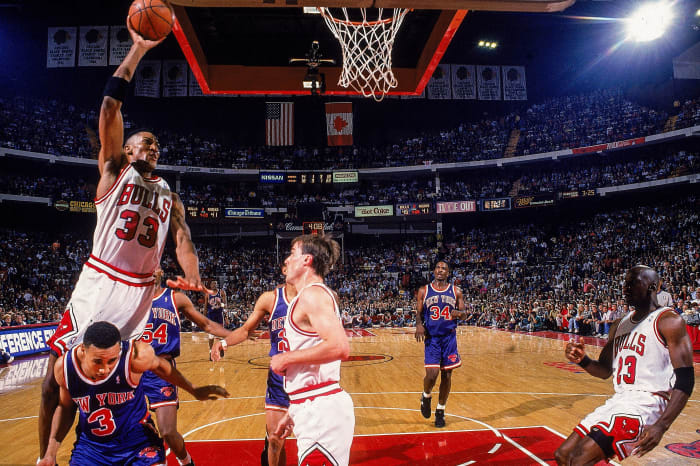
In 1993, a Pippen-led Conference Finals home stand was a stark contrast to Chicago's early effort away.
Manny Millan/Sports Illustrated
It is quite possible that no athlete in any sport has ever performed better than Jordan played in those two playoff series, even as his image was being eviscerated. Though it was Paxson who hit the game-winning jumper in Game 6, it was Jordan who delivered the only other points (10 of them) that the gasping-for-air Bulls scored in the fourth period. He dragged that tired team to the title as if he had them on a rope. And so Bouler, Esquinas, Atlantic City—they all ultimately fade to black, disappearing beneath a barrage of jump shots and twisting layups and no-look passes and tongue-out steals. A comment made by Bulls guard B.J. Armstrong in Episode 5 resonates forcefully: “Michael Jordan didn’t even really play basketball anymore. He just figured out how to win the game. He knew how to steer momentum. He knew how to get guys going. Not only was he that good on the offensive end, he was that good on the defensive end. He was just playing a different game than the rest of us. He let us play, but he was there to win the game.”
***
Since I was around at the time, I should give my quick take on all this. I think:
The Jordan of years ago probably stopped just short of having a gambling “problem,” but only because he had so much damn money.
The Jordan of years ago did have an adrenaline problem, a tendency to attach himself to men who lived on the edge. Was that a reaction to the milk-and-cookies image that started to set in under Dean Smith, in Chapel Hill? I’m not sure. Hehir says Jordan told him, off-camera, that his one regret was associating with shady people. I’ll take that as gospel, because Jordan doesn’t do regret very often.
To address the NBA conspiracy question, which will no doubt be rekindled by next Sunday’s episodes: No, I don’t believe that commissioner Stern quietly ordered Jordan into retirement to take the heat off of the gambling questions. Nor do I believe that Jordan’s gambling or the Esquinas revelations had anything to do with the murder of his father, another presumed subject for next Sunday’s The Last Dance.
But I do believe that Stern—who says of Jordan’s gambling: “It never reached crisis levels in my view”—gave Jordan a much freer pass on the Bouler stuff than he would’ve given another player. Jordan should’ve been fined and perhaps even suspended for lying about the check and embarrassing the league with that kind of personal indiscretion. There was a time that the mere mention of Las Vegas caused Stern to practically break out in hives. Yet in 1992, post-Bouler, he let the Dream Team decamp to Monte Carlo for a week of, er, “practice” before the Barcelona Olympics. That was a nod to Jordan, who, among other teammates, gambled the night away in the Loews casino, NBA security eyeing him all the while.
There were other Dream Team moments in Episode 5, and along with them came a couple of errors.
- Here is Ahmad Rashad back then announcing the coming of the Dream Team: “With United States basketball taking a beating in international play, the call went out for international help. The result? In 1992, for the first time, a team of mostly NBA players will defend Olympic pride.” Incorrect. It was Boris Stankovic, the secretary general of FIBA, who pushed to include NBA players in the Olympics, and the idea had to be sold to Stern, even after the U.S.’s bronze-medal finish in the 1988 Games, in Seoul.
- Jordan is able to wriggle off the hook on the question of whether he was primarily responsible for keeping Isiah Thomas off the Dream Team. No matter how many other players (Pippen, Charles Barkley, Karl Malone, maybe even Magic) didn’t want Thomas, and no matter how little support Isiah got from his own coach, Chuck Daly (from whom he got none), the primary reason Isiah was not on the Dream Team was that Jordan wouldn’t play with him. Now, Hehir does score a point by getting Michael to admit his belief that team camaraderie would’ve been worse with Thomas as a Dream Teamer. I’ve actually never heard Jordan say that before, though it’s no surprise he feels that way.
- Regarding the famed intrasquad scrimmage in Monte Carlo: No, Magic Johnson did not throw a ball into the seats because he was angry at a referee’s call; he did that before the scrimmage because the Dreamers were going through a full-court drill so mechanically. Plus, there always seems to be some sort of strange tape splice when the Monte Carlo scrimmage is shown. In this one, Drexler appears—but he was back in the hotel nursing a sore knee on the day of the scrimmage. (Sorry to sound like a third-grade teacher here, but this is my territory. I have a Dream Team podcast coming out soon.)
Anyway, Hehir pivots to Monte Carlo largely to tell the story of the “Kukoc Game,” thereby answering the Where’s Toni? talk that had emerged after the first few episodes. This is July 27 in Barcelona, Dream Team vs. Kukoc’s Croatia. Jordan and Pippen have vowed to destroy the Croatian because Krause has for two years been raving about Kukoc (whom he nabbed with the 29th pick in the 1990 draft), and, as they see it, withheld an extension for Pippen to save future monies for the pick. And destroy Kukoc they do, holding him to four points in a 103–70 drubbing, Toni looking like one of the Lost Boys throughout the ordeal. There’s a happy ending to that story, of course, since Kukoc eventually becomes a Bull, helps Chicago earn its second threepeat and now is a golfing partner of Jordan’s.
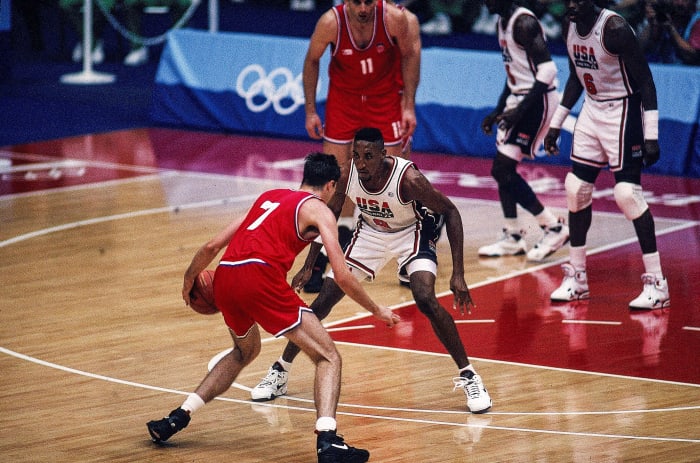
Kukoc's Barcelona nightmare against Pippen, MJ and the Dream Team.
Richard Mackson/Sports Illustrated
Though the Kukoc Game is more about Pippen, it fits snugly into Jordan’s story. Everything—everything—is tinder to the man’s competitive fire.
Let’s return to the beginning of Sunday night’s show and the bittersweet shots of Kobe, with whom Hehir was able to secure an on-camera interview before the events of this January. (The word poignant does not do it justice.) This is Feb. 8, 1998, the All-Star Game at Madison Square Garden, and Jordan zeroes in on the teenage starting shooting guard for the West. “That little Laker boy’s gonna take everybody one-on-one,” Michael says to his Eastern teammate Tim Hardaway before the game. And then: “If I was his teammate I wouldn’t pass him the f---in’ ball.”
Cut to Jordan on the bench: “[Bryant] just wants to get to the offensive end. I’m gonna make his ass work down here.” How much would it have meant to the young Kobe to know that MJ was talking smack about him?
Remember that Kobe is 19, just beginning to make his rep. Jordan is about to turn 35, a five-time champion and a 12-time all-star whose bronze in Springfield is already being cast. Yet Jordan seethes with competitiveness, no doubt because he gazes down from the top of the mountain and sees a challenger with swagger ascending. During his interview, Bryant talks about how much Jordan eventually helped him—“I don’t get five championships without him.” If we close our eyes we can see Jordan at Bryant’s wake, one warrior saluting another, and, damn, it’s sad. If Jordan respected you, he would help you. But he would always want to dominate you. “I’ll see you down the road,” Jordan says to Bryant after that game.
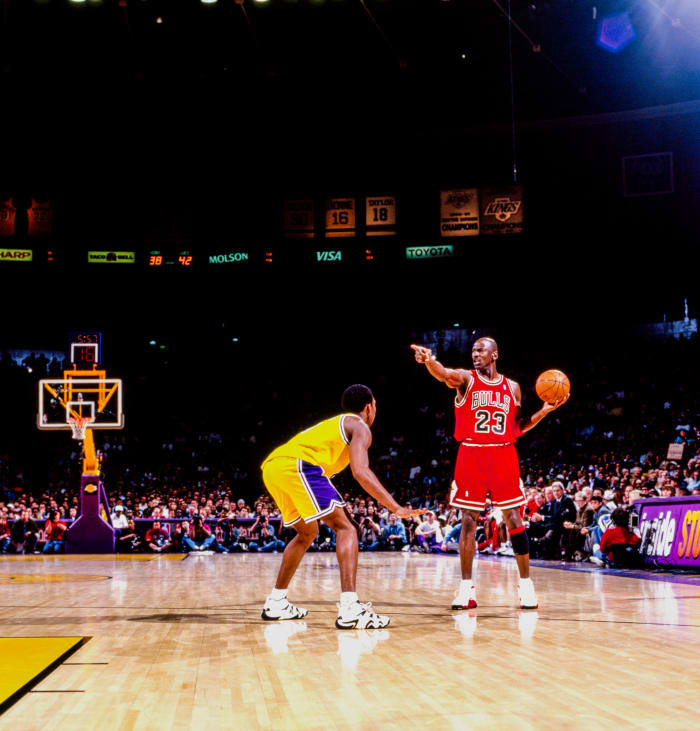
Kobe, on Jordan's influence: “I don’t get five championships without him.”
John W. McDonough/Sports Illustrated
Episode 6 closes with a return to the 1997–98 season, ground zero for The Last Dance. The Bulls are preparing for the postseason that will eventually bring them their second threepeat. Jordan is all but coaching Chicago by that point, yelling at Jackson to end practice, interrupting a Pippen interview so he can get to the golf course, and finally climbing into the driver’s seat of the team bus, obnoxiously tooting the horn. So many challenges has Jordan swatted away by this time that, I swear, I wouldn’t have been shocked if he started the bus and began driving haphazardly down the road, shouting all the while, “Can’t nobody drive like me. … Jerry Krause? … Sheeeeet, he can’t drive no bus … Clyde Drexler ain’t no wheelman. … I’m a damn wheelman. … Isiah? … He can’t drive. … Dan Majerle? … Can’t drive. … Kicked his ass outta the playoffs, didn’t I?” On and on, down the road, to Episodes 7 and 8, Jordan at the wheel. And everybody better get out of the way.
Jack McCallum covered Jordan for years as an SI senior writer and remains a special contributor to the magazine. The author of the New York Times bestseller Dream Team, he is the narrator of the new podcast The Dream Team Tapes, available here.
More From SI.com
Inside the Making of The Last Dance































